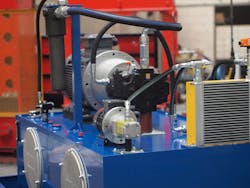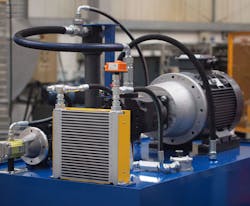Why Your Hydraulic Machine Probably Needs an Oil Cooler—and a Big One!
The inconvenient truth about hydraulic machines is they are heat-generating systems. They are not unique in this respect: Energy conversion and control with 100% efficiency remains elusive. But it’s my contention that unavoidable inefficiency, which manifests as energy contamination of the hydraulic fluid, does not command the attention it deserves.
With the exception of the reservoir, every component in a hydraulic system is a heat-generating device. The process of moving hydraulic fluid through a conductor from A to B results in pressure drop and, therefore, heat generation. Installing depth filters to control particle contamination also creates a pressure drop, which increases heat load. Pumps and motors leak internally, resulting still more heat-generating pressure drops. The charge pump on a hydrostatic transmission is 100% heat load. In open circuits, heat-generating orifices, throttles (in all their various forms), and hydrostats are installed to control direction, flow, and pressure—and loads are counterbalanced by installing hydraulic resistance.
Energy-wasting pressure drops are an unavoidable feature of hydraulic systems.
The point is that energy wasting-pressure drops are a fact of life in hydraulic systems. They can (and should) be minimized, but they can’t be completely eliminated. So let’s stop ignoring the elephant in the room. Because if left unchecked, energy contamination is just as problematic as particle contamination, and arguably more so.
Energy Contamination Affects Lubrication
Adequate lubrication of hydraulic components and efficient power transmission both depend on appropriate oil viscosity. If hydraulic fluid temperature is allowed to exceed that required to maintain viscosity at around 20 centiStokes (cSt), the likelihood of boundary lubrication—resulting in friction and wear—increases dramatically.
The temperature at which this point is reached depends on the fluid’s viscosity grade and its viscosity index (VI). The VI is a measure of an oil’s resistance to change in viscosity with a change in temperature. An oil with a high VI is often called a multi-grade oil. Multi-grade oils are often specified for equipment that must operate in cold. The high VI helps prevent the oil’s viscosity from increasing (thickening) at low temperatures. However, a high VI also helps prevent its viscosity from decreasing (thinning) at high temperatures.
In other words, the critical temperature as far as viscosity is concerned can be relatively low or high, depending on the oil being used. Furthermore, the higher the maximum operating temperature, the wider the temperature operating window becomes. And the wider the temperature operating window, the more difficult it is to maintain oil viscosity within allowable limits.
For example, consider a hydraulic system with a cold start temperature of 5°C (41°F) and a maximum operating temperature of 110°C (230°F). To maintain viscosity between 800 cSt at cold start and 25 cSt at maximum operating temperature requires an ISO VG 150 oil with a viscosity index of 229. This is not a type of hydraulic oil you can just call in and pick up from your local oil supplier. Hydraulic oils in common use have ISO viscosity grades of 22, 32, 37, 46, 68, and 100. A typical monograde hydraulic oil has a VI of around 100, and a multigrade around 150. So even if it was readily available, a VG 150 oil with a VI of 229 would be a premium-priced product, to say the least.
The Exponential Effect of Energy Contamination
Regardless of viscosity limits, which are extremely important for proper lubrication and efficient operation, when it comes to oil, seal, and hose life, the top-end danger temperature is less of a moveable feast. According to Arrhenius's Law, for every 10°C (18°F) increase in temperature, the rate of reaction doubles. The chemical reactions we are concerned with concerning hydraulic oil life are oxidation (from the presence of air) and hydrolysis (from the presence of water). So the hotter the oil, the faster the rate of these reactions, and exponentially so.
By way of illustration, if you pour some cooking oil into a glass, it’ll take days (even weeks) before it darkens in color—a sign of oxidation. But if you pour the same amount of cooking oil into a frying pan, which gives the oil a large contact area with air, and then heat it up, and the oil will go black in a much shorter space of time. If oxidative failure of hydraulic oil is allowed to occur, the byproducts of oil oxidation—varnish and sludge—cause reliability problems, such as clogged filters and valve spool stiction.
Effect of operating temperature on hydraulic oil life. Measurements taken in return-side of reservoir. (Source: Facts Worth Knowing About Hydraulics, Danfoss Fluid Power, p.17.)
The dramatic effect operating temperature has on hydraulic oil life is illustrated in the nomogram shown. If a hydraulic system operates at 85ºC (185ºF), oil life is 12% of what it would be if the system operated at 60ºC (140ºF). If the system operates at 102ºC (216ºF), oil life is just 3% of what it would be if the system operated at 60ºC (140ºF).
Energy Contamination and Thermal Degradation
Heat can damage oil in two ways. The first was just discussed: oxidation. Oxidation is a chemical reaction that is accelerated by high bulk oil temperature and the presence of air. This is “normal” oxidative degradation of the oil.
The second involves intense local heating of the oil. Common causes of localized intense heat are:
- collapse of entrained air bubbles,
- micro-dieseling,
- high watt-density tank heaters,
- large and continuous pressure drops in the system—for example, oil passing over a relief valve—and,
- arcing caused by electrostatic discharge. This process is sometimes referred to as thermal oxidative degradation.
What’s important is that the chemical process of these two forms of oxidative degradation are different, so they show up differently on oil analysis reports. Degradation involving intense local heating produces carbonaceous nitro-nitrates in the oil. Its normally shows up as nitration on a Fourier transform infrared (FTIR) spectroscopy oil analysis report. On the other hand, oil that degrades through “normal” oxidation produces metal carboxylates and carboxylic acids. The amount of these acids—and, therefore, the remaining oil life—is what the Total Acid Number (TAN) test seeks to quantify.
Excessive Heat Damages More Than the Oil
Hydraulic oil is not the only thing affected by energy contamination. The elastomers used to make hydraulic seals and hoses are improving all the time. But oil temperatures above 82°C (180°F) accelerate the degradation of most of these polymers. In fact, according to seal manufacturer Parker Pradifa, operating temperatures 10°C (18°F) above recommended limits can reduce seal life by 80% or more.
Similarly, according to hose manufacturer Gates, exposing a hydraulic hose to an operating temperature 10°C (18°F) above its recommended maximum cuts its expected service life by 50%. This means a single, over-temperature event of significant magnitude can damage all the hoses and seals, “crack” the oil, and result in scuffing and wearing of lubricated surfaces.
If all this isn’t bad enough, the constant cycle of heating and cooling—a process known as aging—is more severe when temperature extremes are greater. Aging causes the polymers used in seals and hoses to lose their elastic properties. The ultimate result is leaking hoses and seals.
Setting Temperature Limits
So what is the dangerous operating temperature number for hydraulic systems? For reasons already explained, to avoid compromising oil, hose, and seal life, I always work on a maximum of 85°C (185°F). However, to avoid compromising viscosity, lubrication, and system efficiency, a much lower temperature may have to be respected: from 85°C (185°F) down to around 50°C (122°F)—or perhaps lower, depending on the grade and type of oil being used, and by extension, the climatic conditions the machine operates in. Staying below these maximum temperature limits year-round will, in most applications, require that the machine’s hydraulic system uses an oil cooler—and in many cases, a big one.
Walter Isaacson’s biography of Steve Jobs tells a story about Jobs demanding that one of the early Macintosh computers could not contain a cooling fan. It was Jobs’ contention that a cooling fan detracts from the user experience—and I’m inclined to agree. When the cooling fan on my Alienware X51-R2 revs up, I do find it mildly annoying. Anyway, despite the initial resistance from his engineers at the time, Jobs prevailed, and the model shipped did not contain a cooling fan on its enclosure.
I mention this story because many hydraulic machine builders and end users share the late Jobs’ dislike for heat rejection devices—oil coolers, in our case. But it can’t be said that an oil cooler on a hydraulic machine detracts from the user experience. Instead, an oil cooler—or an oil cooler of sufficient size—is resisted due to one or more of the following:
- initial cost,
- required maintenance,
- the space it requires, or
- the weight it adds to the machine.
In fact, during a time when I was designing and building hydraulic power units for end users, I can recall dealing with customers whose desire was no oil cooler and the smallest tank possible!
A Bigger Tank is Not the Answer
The idea that increasing tank oil volume can eliminate the need for an oil cooler is flawed—on all but the smallest of systems, in terms of input power. The formula for calculating heat convection from the tank, in SI units, is:
P = ΔT × A × h ÷ 1,000
Where:
P is heat rejected, kW
ΔT is temperature difference between the oil and air, °C
A is surface area of the tank, excluding base, m2
H is the convective heat transfer coefficient for air, W/(m2°C)
Use 12 for a normally ventilated space, 24 for forced ventilation, or 6 for poor air circulation.
Let’s consider a tank with an oil volume of 200 liters and area (excluding its base) of 1.7 m2, an ambient air temperature of 35° C, and an operating oil temperature of 85° C. In a “normally ventilated” space, the theoretical heat rejection of the tank is:
(85-35) × 1.7 × 12 ÷ 1,000 = 1 kW
For the purposes of illustration, let’s say this calculation is too conservative, so we’ll double the above number. In other words, we expect the 200-liter tank will dissipate 2 kW of heat. Working backwards from this number, if we want the hydraulic system to have an installed cooling capacity of 25% of input power (and the tank is the only installed cooling), then the maximum, continuous input power allowable is just 8 kW! Obviously, the idea of a big (or bigger) tank in lieu of an oil cooler is not realistic in most applications.
If you accept the fact that energy-wasting pressure drops are unavoidable in any hydraulic machine, then so, too, is an appropriately sized oil cooler in most applications. Because when it comes to hydraulic machine reliability, uncontrolled energy contamination can be just as bad, or worse, than uncontrolled particle contamination.
Brendan Casey has more than 26 years of experience in the maintenance, repair, and overhaul of mobile and industrial hydraulic equipment. For more information on reducing the operating cost and increasing the uptime of your hydraulic equipment, visit his website.
About the Author
Brendan Casey
Founder and author
Brendan Casey is the founder of HydraulicSupermarket.com and an author of several hydraulic maintenance and troubleshooting books. A hydraulics specialist with an MBA, he has more than 20 years experience in the design, maintenance and repair of mobile and industrial hydraulic equipment. Visit his website, www.hydraulicsupermarket.com, for more information.

Leaders relevant to this article:



